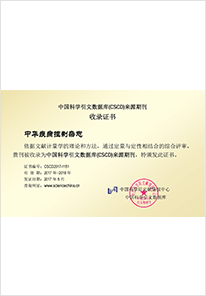2021 Vol. 25, No. 2
Display Method:
2021, 25(2): 125-127, 226.
doi: 10.16462/j.cnki.zhjbkz.2021.02.001
Abstract:
2021, 25(2): 128-132.
doi: 10.16462/j.cnki.zhjbkz.2021.02.002
Abstract:
2021, 25(2): 133-137.
doi: 10.16462/j.cnki.zhjbkz.2021.02.003
Abstract:
2021, 25(2): 143-148.
doi: 10.16462/j.cnki.zhjbkz.2021.02.005
Abstract:
2021, 25(2): 149-154.
doi: 10.16462/j.cnki.zhjbkz.2021.02.006
Abstract:
2021, 25(2): 160-164.
doi: 10.16462/j.cnki.zhjbkz.2021.02.008
Abstract:
2021, 25(2): 165-170.
doi: 10.16462/j.cnki.zhjbkz.2021.02.009
Abstract:
2021, 25(2): 171-175.
doi: 10.16462/j.cnki.zhjbkz.2021.02.010
Abstract:
2021, 25(2): 176-179, 239.
doi: 10.16462/j.cnki.zhjbkz.2021.02.011
Abstract:
2021, 25(2): 180-185.
doi: 10.16462/j.cnki.zhjbkz.2021.02.012
Abstract:
2021, 25(2): 186-191.
doi: 10.16462/j.cnki.zhjbkz.2021.02.013
Abstract:
2021, 25(2): 192-197.
doi: 10.16462/j.cnki.zhjbkz.2021.02.014
Abstract:
2021, 25(2): 198-203.
doi: 10.16462/j.cnki.zhjbkz.2021.02.015
Abstract:
2021, 25(2): 204-210.
doi: 10.16462/j.cnki.zhjbkz.2021.02.016
Abstract:
2021, 25(2): 211-215.
doi: 10.16462/j.cnki.zhjbkz.2021.02.017
Abstract:
2021, 25(2): 216-221.
doi: 10.16462/j.cnki.zhjbkz.2021.02.018
Abstract:
2021, 25(2): 222-226.
doi: 10.16462/j.cnki.zhjbkz.2021.02.019
Abstract:
2021, 25(2): 227-230.
doi: 10.16462/j.cnki.zhjbkz.2021.02.020
Abstract:
2021, 25(2): 231-234.
doi: 10.16462/j.cnki.zhjbkz.2021.02.021
Abstract:
2021, 25(2): 235-239.
doi: 10.16462/j.cnki.zhjbkz.2021.02.022
Abstract:
2021, 25(2): 240-243, 248.
doi: 10.16462/j.cnki.zhjbkz.2021.02.023
Abstract:
2021, 25(2): 244-248.
doi: 10.16462/j.cnki.zhjbkz.2021.02.024
Abstract:


 Email alert
Email alert RSS
RSS Abstract
Abstract HTML
HTML PDF
PDF





